-
 Iron tsuba of round form decorated with eight roundels – circular emblems of flowers and/or family crests (mon) made of cast brass, pierced and chiselled in kebori, and with flat brass inlay (hira-zōgan) of vines or leaves all over the plate. Both hitsu-ana trimmed with brass. Nakago-ana of trapezoidal form. A distinctive character of this tsuba is a mon at 6 hours depicting tomoe (comma). Yoshirō school (Kaga-Yoshirō). Attributed to Koike Yoshirō Naomasa himself. Unsigned. The Momoyama or early Edo period, end of the 16th to the first half of the 17th century (1574-1650). Size: Diameter 82.0 mm, thickness 3.8 mm at seppa-dai, 3.4 mm at rim.
Iron tsuba of round form decorated with eight roundels – circular emblems of flowers and/or family crests (mon) made of cast brass, pierced and chiselled in kebori, and with flat brass inlay (hira-zōgan) of vines or leaves all over the plate. Both hitsu-ana trimmed with brass. Nakago-ana of trapezoidal form. A distinctive character of this tsuba is a mon at 6 hours depicting tomoe (comma). Yoshirō school (Kaga-Yoshirō). Attributed to Koike Yoshirō Naomasa himself. Unsigned. The Momoyama or early Edo period, end of the 16th to the first half of the 17th century (1574-1650). Size: Diameter 82.0 mm, thickness 3.8 mm at seppa-dai, 3.4 mm at rim. -

Iron tsuba of round form decorated with eight roundels – circular emblems of flowers and/or family crests (mon) made of cast brass, pierced and chiseled in kebori, and with flat brass inlay (hira-zōgan) of vines or leaves all over the plate. Both hitsu-ana could have been trimmed with brass now lacking. Nakago-ana of triangular form, possibly enlarged, with copper sekigane. All typical emblems with bellflower, two variations on suhama theme, and 3, 4, 5, and 6-poinitng mon variations. A distinctive character of this tsuba is a mon at 12 hours depicting water plantain (omodaka).
“Omodaka was also called shōgunsō (victorious army grass); because of this martial connotation, it was a design favored for the crests of samurai families” [Family crests of Japan, Stone Bridge Press, Berkeley, California]. Yoshirō school (Kaga-Yoshirō). The Momoyama or early Edo period, beginning of 17th century. Size: Height: 81.4 mm; width: 81.2; thickness 3.8 mm at seppa-dai. -
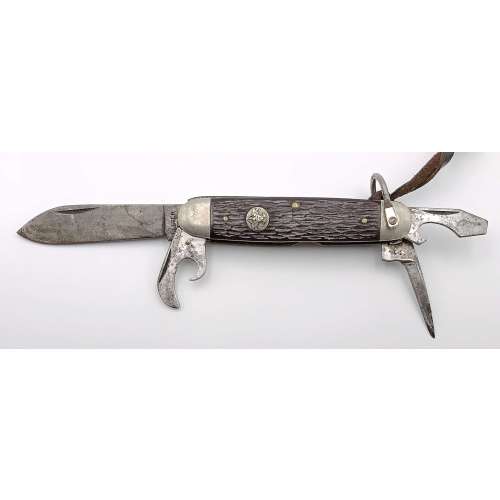
Ulster Official Scout pocket knife with brown jigged bone plastic handles.
Size: 93 mm (closed); 160 mm (opened); 70 mm blade.
Tang is etched with: Ulster -
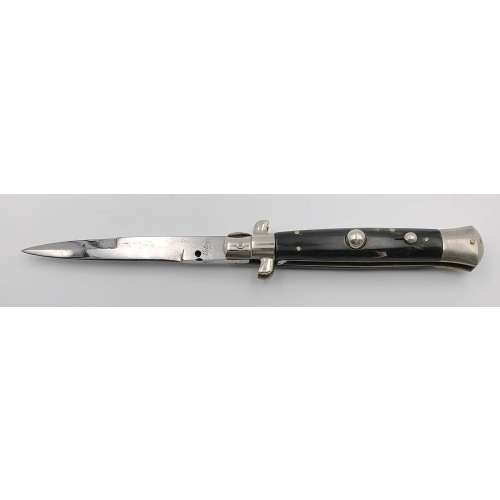
Classical picklock Italian stiletto switchblade knife with bolster release, fixed guard, Brazilian horn handle.
Size: 112 mm (closed); 240 mm (opened); 90 mm blade.
Tang is etched with: Latama, Italy. SOLD -
 Iron tsuba of round form decorated with dragonfly (tombo) and comma (comma-like swirl, tomoe) in openwork (sukashi) outlined with brass wire. The plate decorated with 5 concentric circular rows of brass dots in ten-zōgan. Center of the plate outlined with the inlaid circular brass wire (sen-zōgan). Ōnin school. Unsigned. Mid Muromachi period, middle of the 15th century. Dimensions: Diameter: 89.5 mm, thickness: 3.1 mm. Notes regarding design: "According to various sources, the dragonfly (tombo) is emblematic of martial success, as various names for the insect are homophones for words meaning "victory". The dragonfly is also auspicious because references in the Kojiki and Nihongi link it in both name and shape to the old kingdom of Yamato." [Merrily Baird. Symbols of Japan. Thematic motifs in art and design. Rizzoli international publications, Inc., 2001, p. 108]. "The dragonfly (tonbo), was also called kachimushi in earlier times, and due to the auspicious literal meaning "victory bug" of the characters of this word it became a popular theme on sword fittings." [Iron tsuba. The works of the exhibition "Kurogane no hana", The Japanese Sword Museum, 2014, p. 13]. Helen C. Gunsaulus' description of the dragonfly emblem is as follows: "This motive, the dragon-fly (akitsu), is generally accepted as a symbol of the kingdom of Japan, and the origin of the idea is traced to the legend recounted in the Kojiki and Nihongo of the Emperor Jimmu's view of the island from mountain top. He is said to have thought the kingdom looked like a dragon-fly touching its tail with its mouth. From this it received its name Akitsu-shima... etc."
Iron tsuba of round form decorated with dragonfly (tombo) and comma (comma-like swirl, tomoe) in openwork (sukashi) outlined with brass wire. The plate decorated with 5 concentric circular rows of brass dots in ten-zōgan. Center of the plate outlined with the inlaid circular brass wire (sen-zōgan). Ōnin school. Unsigned. Mid Muromachi period, middle of the 15th century. Dimensions: Diameter: 89.5 mm, thickness: 3.1 mm. Notes regarding design: "According to various sources, the dragonfly (tombo) is emblematic of martial success, as various names for the insect are homophones for words meaning "victory". The dragonfly is also auspicious because references in the Kojiki and Nihongi link it in both name and shape to the old kingdom of Yamato." [Merrily Baird. Symbols of Japan. Thematic motifs in art and design. Rizzoli international publications, Inc., 2001, p. 108]. "The dragonfly (tonbo), was also called kachimushi in earlier times, and due to the auspicious literal meaning "victory bug" of the characters of this word it became a popular theme on sword fittings." [Iron tsuba. The works of the exhibition "Kurogane no hana", The Japanese Sword Museum, 2014, p. 13]. Helen C. Gunsaulus' description of the dragonfly emblem is as follows: "This motive, the dragon-fly (akitsu), is generally accepted as a symbol of the kingdom of Japan, and the origin of the idea is traced to the legend recounted in the Kojiki and Nihongo of the Emperor Jimmu's view of the island from mountain top. He is said to have thought the kingdom looked like a dragon-fly touching its tail with its mouth. From this it received its name Akitsu-shima... etc." -
 Iron tsuba of 14-petal chrysanthemoid form (kikka-gata) with alternating solid and openwork petals, the latter outlined with brass wire (sen-zōgan) and the former decorated with brass dots (ten-zōgan), on both sides. Seppa-dai is outlined with brass wire. Small hitsu-ana probably cut later. Late Muromachi period (Ca. 1514-1573). Ōnin school. Unsigned. Dimensions: 87.0 x 87.8 x 3.2 mm. Similar tsuba in this collection: TSU-0420.2022
Iron tsuba of 14-petal chrysanthemoid form (kikka-gata) with alternating solid and openwork petals, the latter outlined with brass wire (sen-zōgan) and the former decorated with brass dots (ten-zōgan), on both sides. Seppa-dai is outlined with brass wire. Small hitsu-ana probably cut later. Late Muromachi period (Ca. 1514-1573). Ōnin school. Unsigned. Dimensions: 87.0 x 87.8 x 3.2 mm. Similar tsuba in this collection: TSU-0420.2022 Other similar specimens can be found at:
Henri L. Joly and Kumasaku Tomita, Japanese art and handicraft, "Swords and sword fittings" section, sub-section “Inlays of Ōnin, Kyoto, Fushimi-Yoshiro, and Kaga Province”, Plate CX, #128: Iron, chrysanthemoid, thin guard with alternate petals covered with brass spots. Ōnin style. 16th century.
Compton Collection, Part I, #7: The iron plate is of flowerhead shape with each of the fourteen petals alternating between solid and openwork. The apertures are outlined in inlaid brass as is the seppa-dai and hitsu-ana. The remainder of the plate is similarly inlaid with plum flowers, birds, dots of dew, Genji mon and sambiki mon. 87 mm x 85 mm x 3.5 mm.
Other similar specimens can be found at:
Henri L. Joly and Kumasaku Tomita, Japanese art and handicraft, "Swords and sword fittings" section, sub-section “Inlays of Ōnin, Kyoto, Fushimi-Yoshiro, and Kaga Province”, Plate CX, #128: Iron, chrysanthemoid, thin guard with alternate petals covered with brass spots. Ōnin style. 16th century.
Compton Collection, Part I, #7: The iron plate is of flowerhead shape with each of the fourteen petals alternating between solid and openwork. The apertures are outlined in inlaid brass as is the seppa-dai and hitsu-ana. The remainder of the plate is similarly inlaid with plum flowers, birds, dots of dew, Genji mon and sambiki mon. 87 mm x 85 mm x 3.5 mm.
Japanese art and handicraft, Plate CX, #128.
And at Jim Gilbert website: Onin ten zogan tsuba, mid Muromachi. Size: 7.7 cm T x 7.6 cm W x 0.3 cm. Iron plate with brass inlay. Kiku gata. The Ōnin ten zogan style is characterized by the decoration of small brass “nail heads” and wires on a thin iron plate. The iron often has a soft, granular texture and seems to be prone to rust. Unfortunately, this rust will undermine the brass inlay and result in the loss of some of the inlay. This example is in reasonably good but far from perfect condition. As is often the case, the backside is better preserved, with the wire around the seppa-dai and kozuka-ana, and all petals still intact.
Compton Collection, Part I, #7.
-

Tsuba of oval form decorated with vines, tendrils, and leaves on trellis in brass inlay with details carved in kebori, and pierced with six family crests (mon) with two, three and four pointing stars in openwork, each outlined with brass wire and carved in kebori. Original hitsu-ana outlined with brass wire was probably enlarged later. Copper sekigane.
Momoyama to early Edo period (end of the 16th - beginning of the 17th century). Dimensions: 68.3 x 64.5 x 3.4 mm. -

Tsuba of oval form decorated with clematis six-petal flowers, tendrils, and leaves in cast brass with details carved in kebori, inlaid on iron plate carved in low relief (kebori and sukidashi-bori). Hitsu-ana plugged with shakudō. Copper sekigane.
Heianjō (or Ōnin) school. Unsigned. Mid Muromachi period (1454-1513). Dimensions: 87.2 x 84.3 x 4.3 mm. Tsuba is illustrated and described in Gary D. Murtha's "Onin-Heianjo-Yoshiro" book on pages 38-39. Mid-Muromachi is the age attribution by Gary. “A picture book of Japanese sword guards. Victoria & Albert Museum“, published in 1927 presents us with a somewhat similar tsuba: "Floral ornament. Iron, with brass incrustation". V&A attributes the tsuba to Ōnin style, 16th century.
-

Thin iron tsuba of round form pierced with six three-leaf wood sorrels (katabami) in ko-sukashi and inlaid with brass decoration along the rim. Kozuka-hitsu-ana probably cut at a later date.
Late Muromachi or Momoyama period, 16th century. Dimensions: 78.0 x 77.7 x 2.5 mm. -
 Mokkō-form (kirikomi-mokkō-gata) iron plate of grey colour decorated on both sides with waves, reeds, cloud, pagoda, and thatched hut in low relief (sukidashi-bori). The kozuka-hitsu-ana is original, the kogai-hitsu-ana probably cut later (lacks raised rim, fuchidoru). Wide (5.7 mm) raised rim of rounded square dote-mimi type, decorated with fine cross-hatching. Momoyama period, 16th century. Dimensions: Height: 75.9 mm, width: 76.4 mm, Thickness at seppa-dai: 2.3 mm, at rim 4.4 mm. Kamakura-bori tsuba of such a form is unusual. The rim is also unusual; it is possible that cross-hatching was done as a preparatory step for damascening, or the the damascening (gold or silver) disappeared with passage of time.
Mokkō-form (kirikomi-mokkō-gata) iron plate of grey colour decorated on both sides with waves, reeds, cloud, pagoda, and thatched hut in low relief (sukidashi-bori). The kozuka-hitsu-ana is original, the kogai-hitsu-ana probably cut later (lacks raised rim, fuchidoru). Wide (5.7 mm) raised rim of rounded square dote-mimi type, decorated with fine cross-hatching. Momoyama period, 16th century. Dimensions: Height: 75.9 mm, width: 76.4 mm, Thickness at seppa-dai: 2.3 mm, at rim 4.4 mm. Kamakura-bori tsuba of such a form is unusual. The rim is also unusual; it is possible that cross-hatching was done as a preparatory step for damascening, or the the damascening (gold or silver) disappeared with passage of time.
-
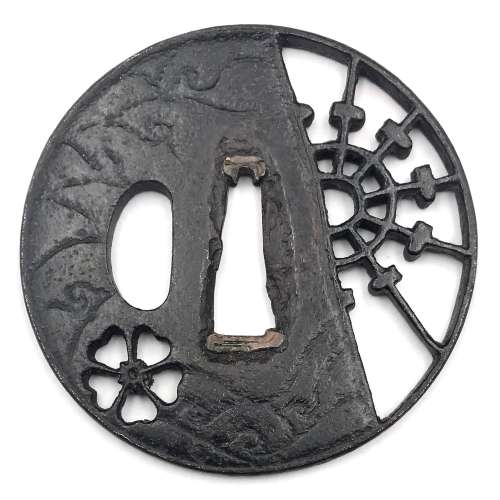 Iron tsuba of round form decorated with design of sea waves in low relief carving (kebori) and pierced with design of cherry blossom in negative silhouette (in-sukashi) and water wheel in positive silhouette (ji-sukashi). The solid portion of the plate has a shallow groove just before the edge. Copper sekigane. School attribution is unclear. Unsigned. Momoyama period, 16th - 17th century. Dimensions: Height: 70.3 mm, width: 71.1 mm, thickness at seppa-dai: 4.4 mm, at rim 4.1 mm. Provenance: Robert E. Haynes, Mark Weisman. This is what shibuiswords.com says about this tsuba:
Iron tsuba of round form decorated with design of sea waves in low relief carving (kebori) and pierced with design of cherry blossom in negative silhouette (in-sukashi) and water wheel in positive silhouette (ji-sukashi). The solid portion of the plate has a shallow groove just before the edge. Copper sekigane. School attribution is unclear. Unsigned. Momoyama period, 16th - 17th century. Dimensions: Height: 70.3 mm, width: 71.1 mm, thickness at seppa-dai: 4.4 mm, at rim 4.1 mm. Provenance: Robert E. Haynes, Mark Weisman. This is what shibuiswords.com says about this tsuba:"A very unusual iron plate tsuba. The solid plate is carved with waves on both sides. A cherry bloom in sukashi, lower left, and the right third of the plate in openwork with design of a water wheel. The rim with some iron bones. The hitsu-ana is original but the shape may have been slightly changed. One would expect this to be the work of the early Edo period, but the age of the walls of the sukashi would suggest that this is a work of the middle Muromachi period. This must be the forerunner for the Edo examples we see of this type of design." (Haynes)
I managed to find a look-a-like tsuba in Haynes Catalog #5, 1983, pp. 20-21, №44: "Typical later Heianjo brass inlay example. Ca. 1725. Ht. 7 cm., Th. 4.5 mm., $100/200".We see that the plate design of both tsuba is the same, and the only difference is the trim. It would be logical to assume that both pieces were made at about the same time, rather than 225 years apart. To be fair, let's accept that they were made in Momoyama period.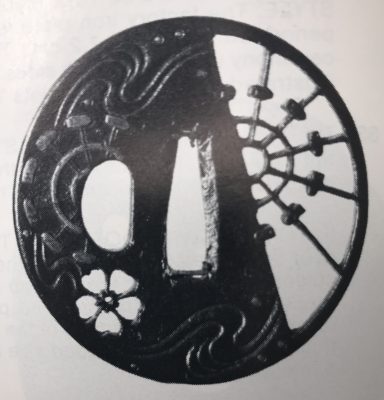
Haynes Catalog #5, 1983, pp. 20-21, №44.
-
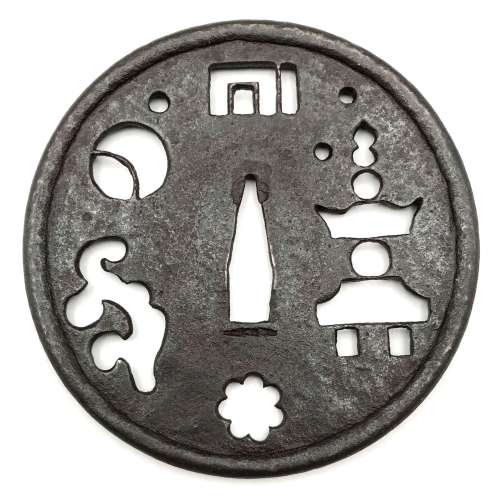 Iron tsuba of round form decorated with design of moon, stars, cloud, snowflake, gorintō, and Genji-mon in negative openwork (in-sukashi). Raised tubular rim (dote-mimi). Deep black patina, traces of lacquer. Naka-daka type of plate (thicker in center, getting thiner towards the rim). Visible gap between the rim and the plate. Dimensions: Height: 91.7 mm; Width: 90.8 mm; Thickness at seppa-dai: 2.5 mm, plate before rim: 2.2 mm, of the rim: 5.6 mm. At least Mid Muromachi period, 15th century, but possibly earlier. In 'Silver Book', commenting tsuba №34 Sasano writes: "The technique used to create the rim is the same used for the peak (koshimaki) of helmets (kabuto) during the Kamakura and Nanbokucho periods." On the other hand, the abundance of sukashi elements points towards later times, perhaps late Muromachi or even Momoyama period. "Gorintō is a grave stone composed of five pieces, piled on one the other, representing, from the bottom upward, earth, water, fire, wind, and heaven, respectively" [Nihon Tō Kōza, Volume VI, Part 1. AFU, 1993, p. 6. / LIB-1554]. A romantic description of the piece may look like this: The air is scented (incense symbol); it's a graveyard, marked by gorintō; a winter (snowflake) evening or night (moon, stars); mist is rising from a ravine towards moon. I did not manage to find a katchūshi piece of this design, only a few Kamakura-bori tsuba:
Iron tsuba of round form decorated with design of moon, stars, cloud, snowflake, gorintō, and Genji-mon in negative openwork (in-sukashi). Raised tubular rim (dote-mimi). Deep black patina, traces of lacquer. Naka-daka type of plate (thicker in center, getting thiner towards the rim). Visible gap between the rim and the plate. Dimensions: Height: 91.7 mm; Width: 90.8 mm; Thickness at seppa-dai: 2.5 mm, plate before rim: 2.2 mm, of the rim: 5.6 mm. At least Mid Muromachi period, 15th century, but possibly earlier. In 'Silver Book', commenting tsuba №34 Sasano writes: "The technique used to create the rim is the same used for the peak (koshimaki) of helmets (kabuto) during the Kamakura and Nanbokucho periods." On the other hand, the abundance of sukashi elements points towards later times, perhaps late Muromachi or even Momoyama period. "Gorintō is a grave stone composed of five pieces, piled on one the other, representing, from the bottom upward, earth, water, fire, wind, and heaven, respectively" [Nihon Tō Kōza, Volume VI, Part 1. AFU, 1993, p. 6. / LIB-1554]. A romantic description of the piece may look like this: The air is scented (incense symbol); it's a graveyard, marked by gorintō; a winter (snowflake) evening or night (moon, stars); mist is rising from a ravine towards moon. I did not manage to find a katchūshi piece of this design, only a few Kamakura-bori tsuba: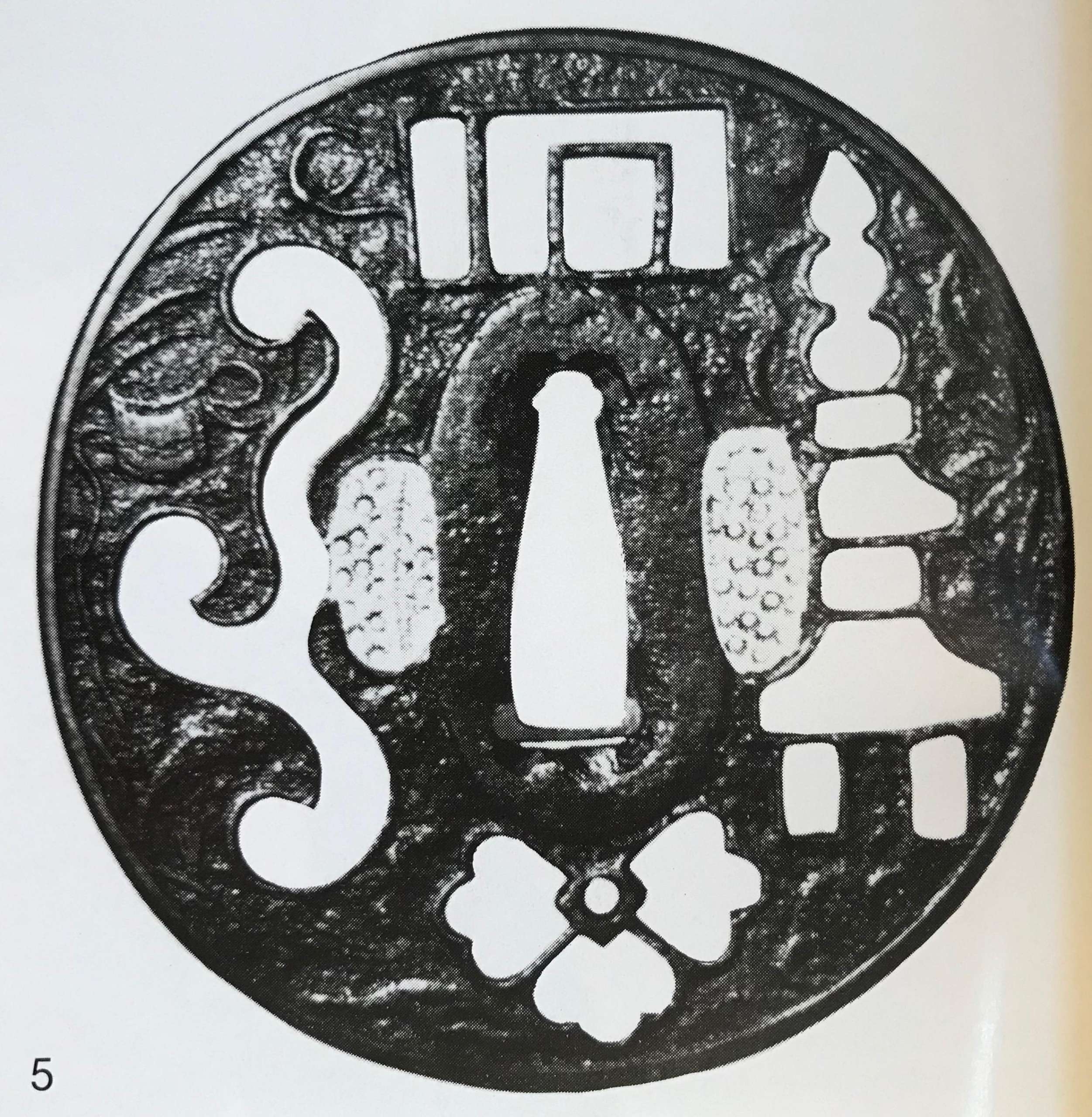
100 selected tsuba from European collections. Catalogue by Robert Haynes and Robert Burawoy, 1984, page 16, №5.
While the upper tsuba is dated the end of Muromachi, the lower is attributed to the 17th century - Momoyama or early Edo period, though the author put this attribution under question. Deciphering of the strangely shaped opening to the left of nakago-ana is sometimes "a conventional scroll", and sometimes - a fern or bracken. I think mine is a cloud or mist, but I don't have any material evidence to prove this understanding, and I came to a conclusion based only on context. It may easily be dinosaurs playing ball. The fact that this thing always accompanies the Genji-mon, or incense symbol, it may be a scent itself.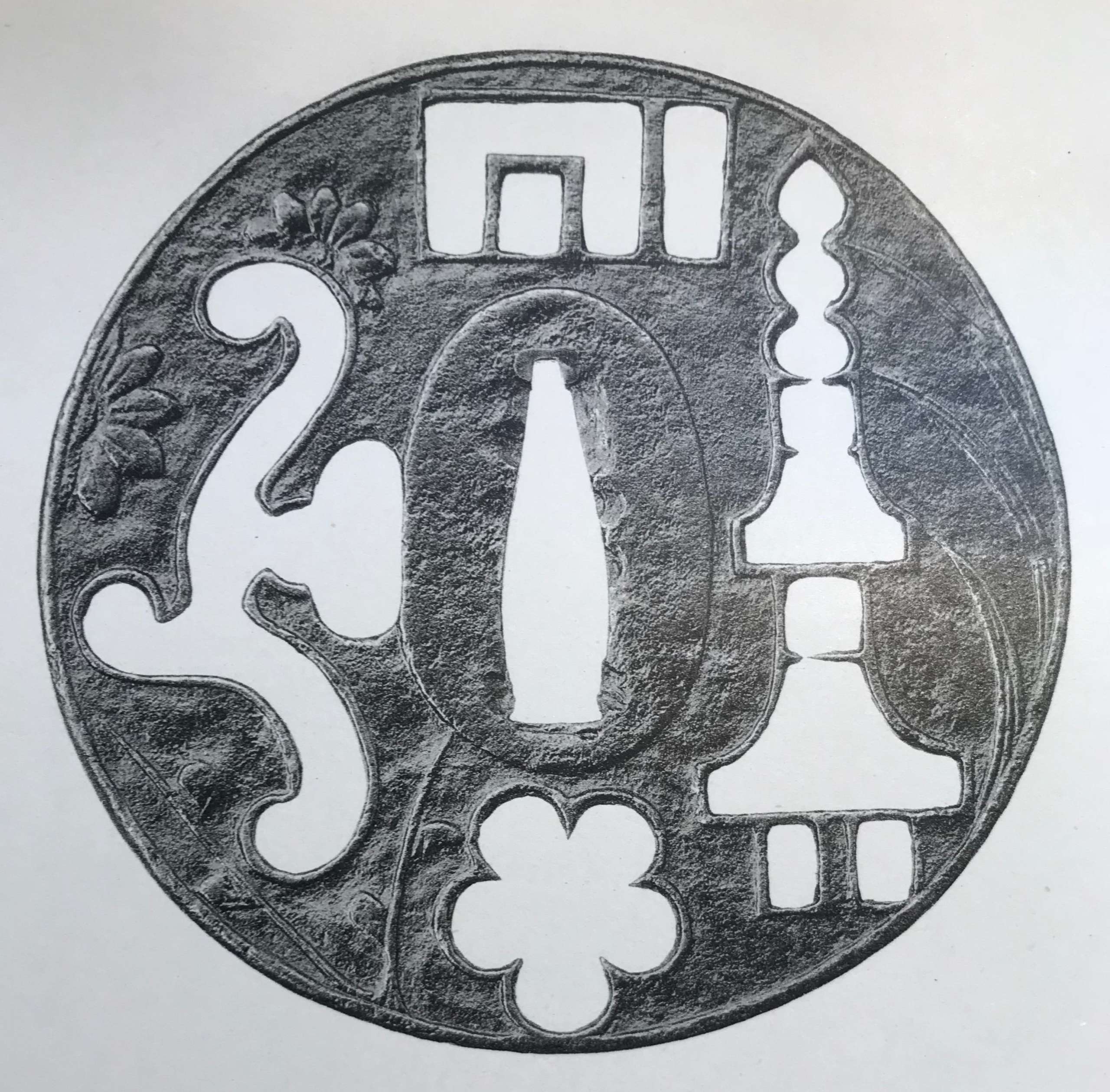
Japanese Sword Fittings. Collection of G.H. Naunton, Esq., by Henri L. Joly, - 1912; №9.
-
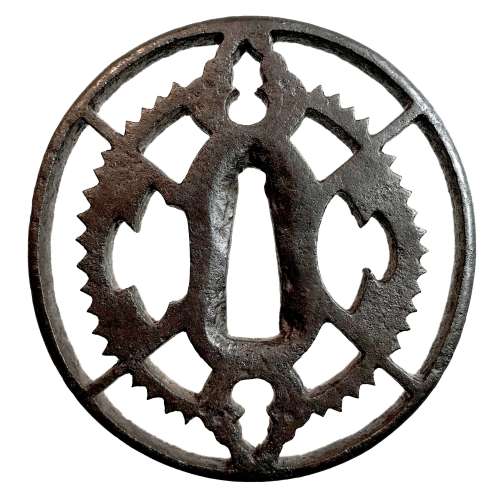
Iron tsuba of oval form pierced with design of slanting rays of light (shakoh), a Christian motif (Jesuit’s IHS symbol), and a pair of tassels in positive silhouette (ji-sukashi). Details on tassels carved in low relief. Traditional description of this kind of design is called “tokei”, or “clock gear”. Rounded rim.
Unsigned.
Edo period, 17th or 18th century. Possibly - Owari school.
Size: 76.0 x 73.0 x 6.2 mm. -
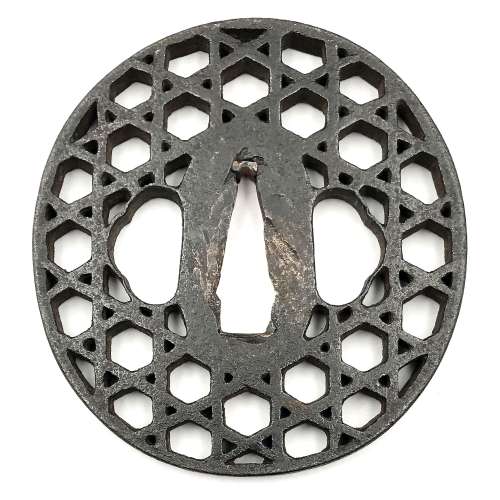
Iron tsuba of oval form decorated with design of jakago (bamboo lattice work) in openwork (sukashi). Copper sekigane.
Unsigned. Edo period.
Size: 73.7 x 70.3 x 5.6 mm.Note regarding design: though some might think that this piece belonged to a member of the lost tribe of Israel, it did not. Jakago baskets were made of bamboo, filled with rocks and used to catch crabs (besides other uses).
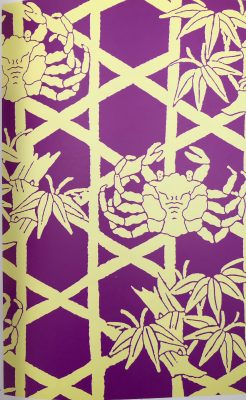
Jeanne Allen. Designer's Guide to Samurai Patterns. Chronicle Books, San Francisco, 1990; p.51, №57.
-

Iron tsuba of round form inlaid with brass and shakudo (suemon-zōgan) with a design of tendrils, leaves, double gourds, and folding fan with two wild geese on the face and the same design only with a fan with two interlocked rings (wachigai) on the back. Design is supplemented with a round family crest (mon) of three fans in openwork (sukashi). Hitsu-ana and the mon are outlined with brass rope. Copper sekigane.
Some attribute such tsuba as belonging to Heianjō or even Yoshirō School, and date them to Momoyama period. I keep this piece under Ōnin rubric, late Muromachi, but this is just a question of personal preference.Some inlay is missing, some repaired; traces of rust. Otherwise - decent condition.
Late Muromachi period (1514-1573). Size: 77.4 x 77.1 x 3.8 (center), 3.2 (rim) mm -
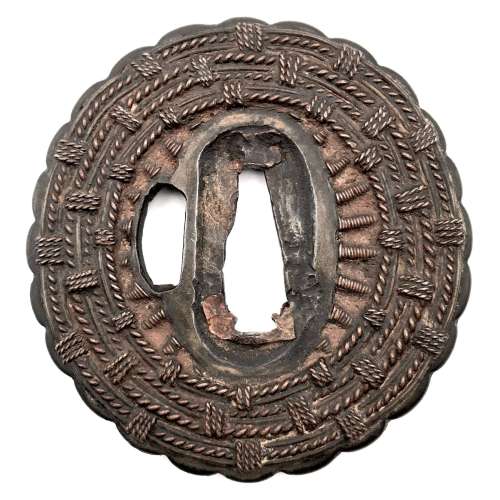 Tsuba of chrysanthemoid form (kikka-gata) with yamagane core and woven copper wire pattern. Copper sekigane. Shingen school. Height: 70.2 mm; Width 67.2 mm; Thickness at seppa-dai: 3.4-3.6 mm, overall 7.3 mm. Weight 82.7 g Inscription on the wooden box reads: "Muromachi period Mumei Zōgan Shingen Tsuba" Muromachi period, 16th century. Age attribution is based on the fact that the core is made of yamagane; later copies of Edo period are usually made of iron. This small and light tsuba was likely mounted on a combat sword, while larger and much heavier woven wire Shingen tsuba of Edo period were of purely decorative purpose. http://varshavskycollection.com/shingen-tsuba/
Tsuba of chrysanthemoid form (kikka-gata) with yamagane core and woven copper wire pattern. Copper sekigane. Shingen school. Height: 70.2 mm; Width 67.2 mm; Thickness at seppa-dai: 3.4-3.6 mm, overall 7.3 mm. Weight 82.7 g Inscription on the wooden box reads: "Muromachi period Mumei Zōgan Shingen Tsuba" Muromachi period, 16th century. Age attribution is based on the fact that the core is made of yamagane; later copies of Edo period are usually made of iron. This small and light tsuba was likely mounted on a combat sword, while larger and much heavier woven wire Shingen tsuba of Edo period were of purely decorative purpose. http://varshavskycollection.com/shingen-tsuba/ -
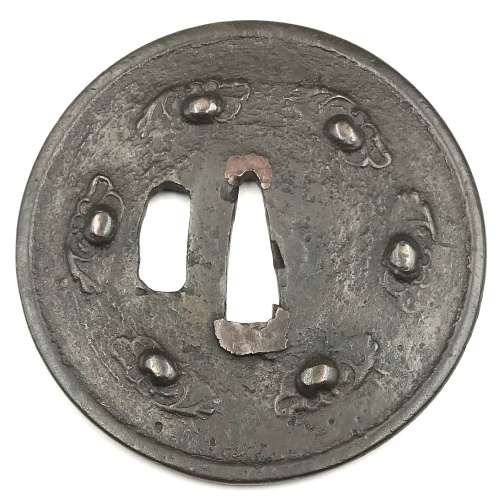 Circular form tsuba made by a mirror-maker, i.e. kagamishi. Cast yamagane plate with design of six persimmons on their peduncles surrounded by leaves. Slightly raised rounded square rim. Hitsu-ana is brutally cut later in time. Copper sekigane. Early Muromachi period (1393-1457) or earlier. The inscription on the box reads: "Kamakura or Muromachi Period. Yamagane Tsuba". Dimensions: 81.9 x 81.6 mm; thickness at seppa-dai 2.8 - 3.0 mm, rim 3.4 mm.
Circular form tsuba made by a mirror-maker, i.e. kagamishi. Cast yamagane plate with design of six persimmons on their peduncles surrounded by leaves. Slightly raised rounded square rim. Hitsu-ana is brutally cut later in time. Copper sekigane. Early Muromachi period (1393-1457) or earlier. The inscription on the box reads: "Kamakura or Muromachi Period. Yamagane Tsuba". Dimensions: 81.9 x 81.6 mm; thickness at seppa-dai 2.8 - 3.0 mm, rim 3.4 mm. -
 A circular iron tsuba with a design of three monkey toys (kukurizaru) in small openwork (ko-sukashi); the plate further decorated with four rows of brass dot inlay (ten-zogan). The center of the plate and the openings are outlined with brass wire. Copper sekigane. A few dots missing. Muromachi period. Dimensions: 89.0 x 88.2 x 2.9 mm. Kukurizaru was an often used motif on old tsuba. The symbol has two explanations: (1) "upright" monkey, a sort of roly-poly toy, alludes to 'never-ever give up' property of the samurai; (2) monkeys are represented with their hands and feet tied to their back to symbolize self-control. Other examples of the same design:
A circular iron tsuba with a design of three monkey toys (kukurizaru) in small openwork (ko-sukashi); the plate further decorated with four rows of brass dot inlay (ten-zogan). The center of the plate and the openings are outlined with brass wire. Copper sekigane. A few dots missing. Muromachi period. Dimensions: 89.0 x 88.2 x 2.9 mm. Kukurizaru was an often used motif on old tsuba. The symbol has two explanations: (1) "upright" monkey, a sort of roly-poly toy, alludes to 'never-ever give up' property of the samurai; (2) monkeys are represented with their hands and feet tied to their back to symbolize self-control. Other examples of the same design:
The Henry D. Rosin Collection №9.

Lundgren Collection №7.


